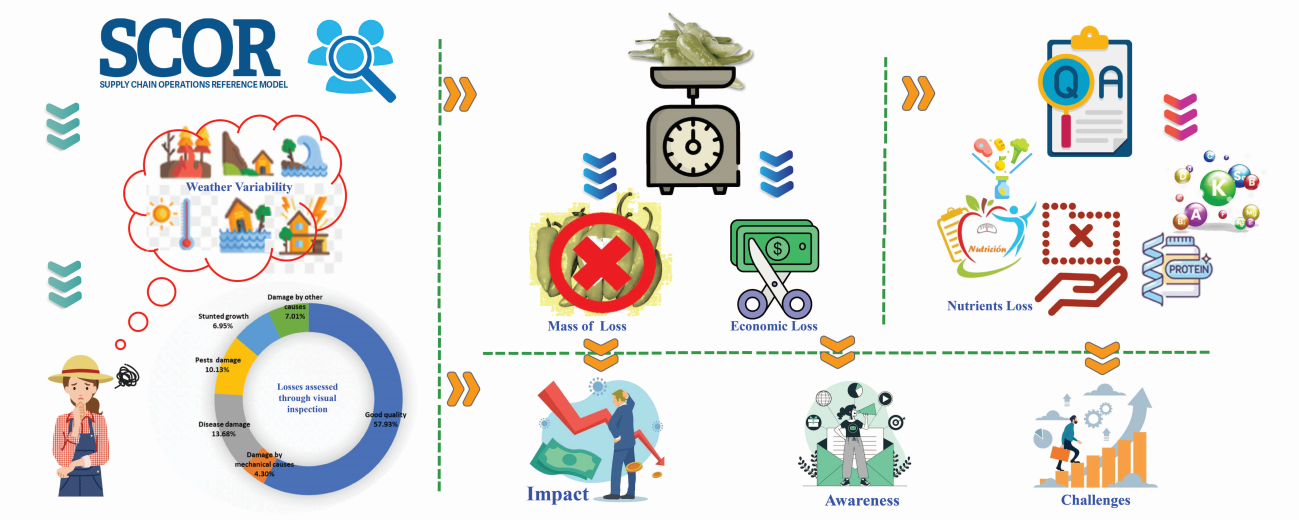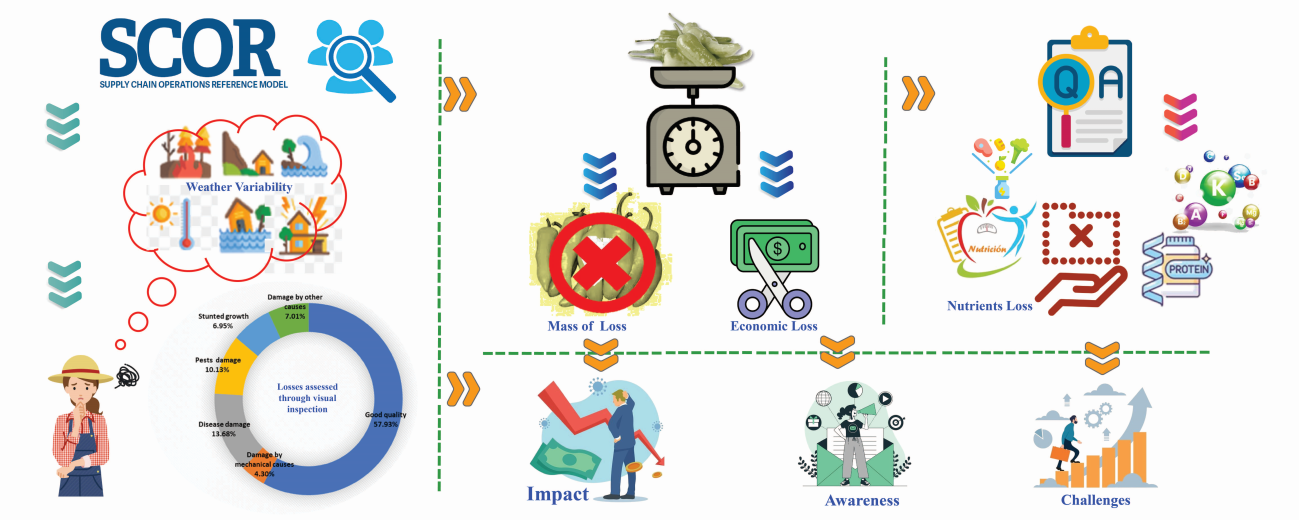Analyzing Food Loss in Banana Pepper (Capsicum annuum) Production: Causes, Impact, and Challenges, A Case Study of Large-Scale Farming in the Hot District, Chiang Mai, Thailand
DOI:
https://doi.org/10.48048/tis.2024.7539Keywords:
On-farm food loss, Banana peppers, Food loss, SCOR model, Food securityAbstract
This study aimed to assess both quantitative and qualitative food loss in banana pepper production at the agricultural level. Its objectives included employing the Supply Chain Operations Reference Model (SCOR Model) for analysis, identifying root causes of losses and evaluating quantity and quality. Food loss here refers to diminished quantity and quality due to supply chain decisions and actions. Data collection and analysis included an extensive literature review, compilation of secondary data, primary data gathering via questionnaires and measurements of lost banana pepper yield during harvesting. Qualitative insights were acquired through in-depth interviews and focus group discussions. The study identified weather variability as the primary driver of food loss, with many farmers lacking access to climatic measuring tools. Additional losses, assessed visually, comprised damage from diseases, pests, stunted growth, mechanical issues and other factors, accounting for 13.68, 10.13, 6.95, 4.03 and 7.01 % of the total loss, respectively. Remarkably, only 57.93 % of the produce met quality and sale readiness criteria. The loss of banana peppers was estimated at 55.21 %, equivalent to 1,189.62 kg/rai, resulting in an economic loss of 35,688.58 Baht/rai. The study also noted significant nutrient losses, including energy, carbohydrates, fiber, protein, potassium, phosphorus, vitamin B1 and vitamin C, amounting to 321,197 kcal/rai and 57,102, 38,068, 17,844 g/rai and 3,045,427, 559,121, 487,744, 166,547 mg/rai, respectively. Farmers, while aware of food loss issues, often struggle to quantify them accurately. This study’s findings can raise farmers’ awareness and aid in designing training programs to mitigate such losses. However, addressing the inherent variability and unpredictability of on-farm food loss remains a challenge. Future research should prioritize a comprehensive analysis of banana pepper losses on farms.
HIGHLIGHTS
- Weather variability was identified as the primary driver of food loss, exacerbated by limited access to climatic measuring tools
- Various factors contribute to food loss, including damage from diseases, pests, stunted growth and mechanical issues, accounting for 68 to 7.01 % of total loss
- Significant economic and nutrient losses, with a 21 % loss of banana peppers, resulting in an economic loss of 35,688.58 Baht/rai and substantial nutrient losses in various categories
GRAPHICAL ABSTRACT

Downloads
Metrics
References
P Julian, M Barthel and S Macnaughton. Food waste within food supply chains: Quantification and potential for change to 2050. Phil. Trans. Biol. Sci. 2010; 365, 3065-81.
United Nations Thailand. Sustainable development goals, Available at: https://thailand.un.org/en/sdgs, accessed January 2020.
J Gustavsson, C Cederberg and U Sonesson. Global food losses and food waste. Food and Agriculture Organization, Duesseldorf, Germany, 2011.
M Herrero, PK Thornton, AM Notenbaert, S Wood, S Msangi, HA Freeman and A Omolo. Addressing food loss and waste: A major opportunity for improving food security and environmental sustainability. Global Food Secur. 2015; 2, 287-92.
J Fanzo, C Davis, R McLaren, J Choufaniand and PE Wilde. The effect of food losses on dietary quality: Nutrient and greenhouse gas emissions. Food Pol. 2018; 74, 120-8.
FC Padilla, MP Romero and F Guillén. Characterization and causes of the severe food losses in banana fruits (Musa spp.) along the supply chain, a case study in the Canary Islands. J. Cleaner Prod. 2017; 165, 1462-72.
A Sharma, K Prasad and M Rai. Pre- and post-harvest management practices for reducing losses in banana production. J. Horticultural Sci. 2019; 14, 61-70.
Wikipedia. Banana pepper, Available at: https://en.wikipedia.org/wiki/Banana_pepper, accessed July 2023.
T Ruamsuke and P Ongkunaruk. Supply chain analysis of import fresh fruit business in Thailand using the supply chain operations reference (SCOR) model. E3S Web Conferences 2021; 316, 02014.
PK Alimo. Reducing postharvest losses of fruits and vegetables through supply chain performance evaluation: An illustration of the application of SCOR model. Int. J. Logist. Syst. Manag. 2021; 38, 384-407.
Institute of Nutrient Mahidol University. Thai food composition database, Available at http://www.inmu.mahidol.ac.th/thaifcd, accessed July 2023.
Chiang Mai Agricultural Extension Office. Information and Publications, 2019.
JW Creswell. Research design: Qualitative, quantitative, and mixed methods approach. 3rd ed. SAGE Publications, Delhi, India, 2009.
C Hanson, B Lipinski, K Robertson, D Dias, I Gavilan, P Gréverath, S Ritter, J Fonseca, R VanOtterdijk, T Timmermans, J Lomax, C O’Connor, A Dawe, R Swannell, V Berger, M Reddy, D Somogyi, B Tran, B Leach and T Quested. Food loss and waste accounting and reporting standard: Food loss and waste protocol. World Resources Institute, Washington DC, 2016.
N Chairany, A Padhil, A Mailand and N Rauf. Risk analysis of supply chain food loss on fishery products using failure mode effect and supply chain operation reference model. Ind. Eng. Manag. Syst. 2023; 22, 31-42.
F Lestari, Mawardi, D Diniaty and Syamsurizal. SCOR model for measuring performance of halal supply chain. Int. J. Publ. Sector Manag. 2023; 11, 341-54.
T Tongmak, P Wararatchai, C Jotikasthiraand and S Onputtha. Enhancing Thailand’s durian export capabilities through SCOR model: Thailand to China. Int. J. Adv. Res. Econ. Finance 2023; 5, 161-8.
LOR Mañay, I Guaita-Pradas and I Marques-Perez. Measuring the supply chain performance of the floricultural sector using the SCOR model and a multicriteria decision-making method. Horticulturae 2022; 8, 168.
Talaadthai. Price information of agricultural products, Available at: https://talaadthai.com/product/9-04-02bananapepper-peeleddate=2022-08-20, accessed April 2023.
VS Magalhaes, LMD Ferreiraand and C Silva. Prioritising food loss and waste mitigation strategies in the fruit and vegetable supply chain: A multi-criteria approach. Sustain. Prod. Consumption 2022; 31, 569-81.
J Schmitt, F Offermann, M Söder, C Frühauf and R Finger. Extreme weather events cause significant crop yield losses at the farm level in German agriculture. Food Pol. 2022; 112, 102359.
K Bunya-atichart. Postharvest management and effects on quantity and quality losses of leafy vegetables. Princess Naradhiwas Univ. J. 2015; 7, 148-9.
D Boonyakiat, PB Poonlarp, C Chuamuangphan and M Janta. Postharvest losses on supply chain of vegetables in the Royal Project Foundation. Agr. Sci. J. 2012; 43, 376-9.
A Chompupoung. Reducing the loss of vegetable productivity at the height land field of the Royal Project Foundation. In: Proceedings of the Seminar on Thai Sustainable Development Perspective on Food Loss and Waste, Bangkok, Thailand. 2017.

Downloads
Published
How to Cite
Issue
Section
License
Copyright (c) 2023 Walailak University

This work is licensed under a Creative Commons Attribution-NonCommercial-NoDerivatives 4.0 International License.






